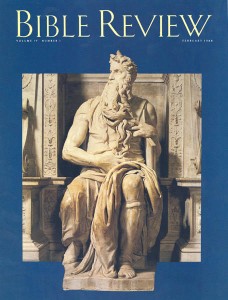Depicting Moses with horns on his head may strike some as a school-boy’s prank, or an act of whimsy. It is in fact a popular artistic tradition more than 900 years old. Viewers startled by the sinister quality that such horns incongruously impart to Moses’ image may well wonder why this tradition arose. As William H. Propp shows in “Did Moses Have Horns?” the artists were merely being faithful to a disputed translation of single Hebrew word from Exodus. Propp examines the controversy surrounding this word and offers an interpretation that may help to resolve the issue.

Propp is an assistant professor in Hebrew language and Bible studies at the University of California at San Diego. He received his Ph.D. from Harvard University, in the Department of Near Eastern Languages and Civilizations. His dissertation will be published in Harvard Semitic Monographs later this year under the title Water in Wilderness: A Biblical Motif and its Mythological Background.
Already a library member? Log in here.
Institution user? Log in with your IP address.

